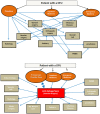The system of care for the diabetic foot: objectives, outcomes, and opportunities
- PMID: 24130936
- PMCID: PMC3796020
- DOI: 10.3402/dfa.v4i0.21847
The system of care for the diabetic foot: objectives, outcomes, and opportunities
Abstract
Most cases of lower extremity limb loss in the United States occur among people with diabetes who have a diabetic foot ulcer (DFU). These DFUs and the associated limb loss that may occur lead to excess healthcare costs and have a large negative impact on mobility, psychosocial well-being, and quality of life. The strategies for DFU prevention and management are evolving, but the implementation of these prevention and management strategies remains challenging. Barriers to implementation include poor access to primary medical care; patient beliefs and lack of adherence to medical advice; delays in DFU recognition; limited healthcare resources and practice heterogeneity of specialists. Herein, we review the contemporary outcomes of DFU prevention and management to provide a framework for prioritizing quality improvement efforts within a resource-limited healthcare environment.
Keywords: delivery of healthcare; diabetes; diabetic neuropathy; foot ulcer; peripheral vascular disease; physician's practice patterns.
Figures




References
-
- Pecoraro RE, Reiber GE, Burgess EM. Pathways to diabetic limb amputation. Basis for prevention Diabetes Care. 1990;13:513–21. - PubMed
-
- Schaper NC, Andros G, Apelqvist J, Bakker K, Lammer J, Lepantalo M, et al. Specific guidelines for the diagnosis and treatment of peripheral arterial disease in a patient with diabetes and ulceration of the foot 2011. Diabetes Metab Res Rev. 2012;28(Suppl 1):236–7. - PubMed
-
- Anichini R, Zecchini F, Cerretini I, Meucci G, Fusilli D, Alviggi L, et al. Improvement of diabetic foot care after the implementation of the International Consensus on the Diabetic Foot (ICDF): results of a 5-year prospective study. Diabetes Res Clin Pract. 2007;75:153–8. - PubMed
-
- National Cancer Institute. SEER stat fact sheet: colon and rectum. Available from: http://seer.cancer.gov/statfacts/html/colorect.html [cited 27 November 2012]
-
- National Cancer Institute. The cost of cancer. Available from: http://www.cancer.gov/aboutnci/servingpeople/cancer-statistics/costofcancer [cited 23 November 2012]
Publication types
Grants and funding
LinkOut - more resources
Full Text Sources
Other Literature Sources
Medical
